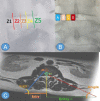Advancing Education in Endoscopic Spinal Navigation: Novel Methods and Technical Note
- PMID: 37143617
- PMCID: PMC10153653
- DOI: 10.7759/cureus.37017
Advancing Education in Endoscopic Spinal Navigation: Novel Methods and Technical Note
Abstract
This report aims to demonstrate how to teach anatomy and understanding of spinal endoscopic vision and navigation using mnemonics. The authors present a new surgical technique for teaching endoscopic spinal navigation in a didactic manner with tips such as the "rule of the hand" and decomposition of the endoscopic navigation movement. We demonstrate how the surgery is seen and illustrate how images are projected onto the screen, then divide the navigation into spatial orientation and self-navigation. The article describes the proper puncture technique, how to introduce the working portal, and how to assimilate this new anatomical vision using the "rule of the hand." The surgeon projects their hand on the video screen to guide themselves when starting the navigation and uses the same technique to localize regions of interest during surgery. Finally, the authors break down the navigational movement into three components: forceps positioning, triangulation, and joystick motion. One of the biggest challenges when learning spinal endoscopic surgery is understanding the anatomy seen through the endoscope. By decomposing movements required for navigation, one can understand how to make proper use of the equipment as well as improve their knowledge of this "new anatomy." The learning methods taught in this article have the potential to decrease the learning curve and radiation exposure to those that are still acquainting themselves to spinal endoscopic navigation. We recommend that further studies measure and quantify the impact of these methods on surgical practice.
Keywords: endoscopic navigation; endoscopic spinal surgery; endoscopic surgery; innovative teaching learning; lumbar spine surgery; minimally-invasive spine surgery; spine; spine technology; surgery spine.
Copyright © 2023, Pertile et al.
Conflict of interest statement
The authors have declared that no competing interests exist.
Figures







References
-
- Decompression of lumbar lateral spinal stenosis: full-endoscopic, interlaminar technique (Article in German) Ruetten S, Komp M, Hahn P, Oezdemir S. Oper Orthop Traumatol. 2013;25:31–46. - PubMed
-
- Awake, endoscopic revision surgery for lumbar pseudarthrosis after transforaminal lumbar interbody fusion: technical notes. Telfeian AE, Moldovan K, Shaaya E, Syed S, Oyelese A, Fridley J, Gokaslan ZL. World Neurosurg. 2020;136:117–121. - PubMed
-
- Transforaminal endoscopic discectomy with foraminoplasty for the treatment of spondylolisthesis. Jasper GP, Francisco GM, Telfeian AE. https://www.painphysicianjournal.com/linkout?issn=&vol=17&page=E703 Pain Physician. 2014;17:703–708. - PubMed
-
- Clinical outcome of posterolateral endoscopic surgery for pyogenic spondylodiscitis: results of 15 patients with serious comorbid conditions. Ito M, Abumi K, Kotani Y, Kadoya K, Minami A. Spine (Phila Pa 1976) 2007;32:200–206. - PubMed
LinkOut - more resources
Full Text Sources
